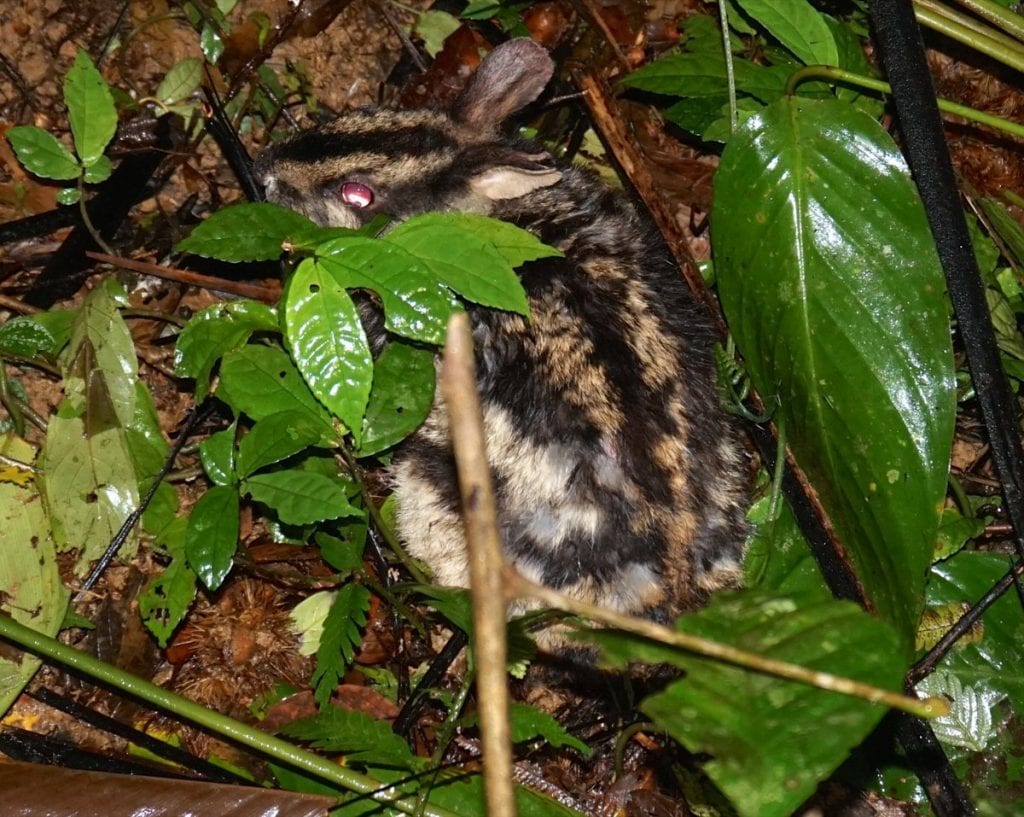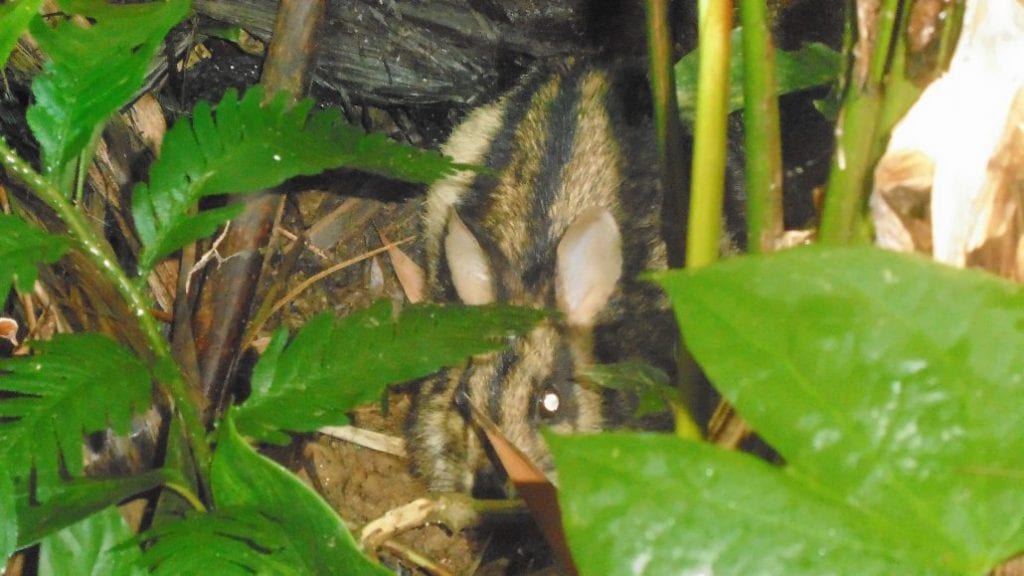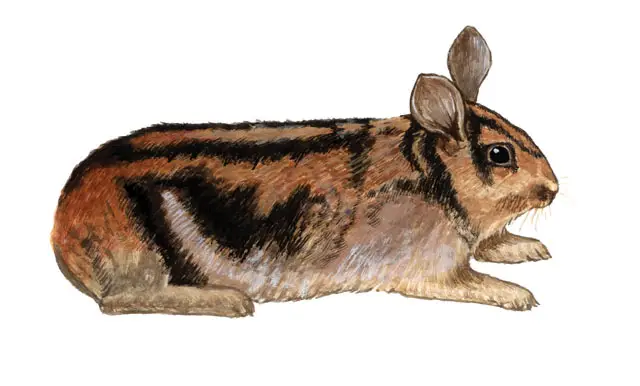Scientific Facts
| Common Name: | Annamite striped rabbit |
| Scientific Name: | Nesolagus timminsi |
| Life Span: | unknown |
| Size: | 4.4 to 6.6 pounds |
| Habitat: | Dense forests and rainforests |
| Country of Origin: | Vietnam and Laos |
Fast Facts
Best Suited For: families and singles
Temperament: shy, nocturnal
Comparable Breeds: Sumatran striped rabbits
Physical Description

The Annamite striped rabbits are jungle-dwelling creatures that became known by mankind in 1995. Their discovery took place at the time a naturalist from Britain found unusual-looking skins in the local market in Laos. Those skins came from a rabbit with short legs, tiny ears, rust-colored rumps, and tiger-like stripes. Though those skins look like that of the Sumatran striped rabbits, the Annamite striped rabbits were different.
These rabbits are somewhat the same as their related cousins Sumatran striped rabbits. They do have grey hair with 7 dorsal stripes on their heads and bodies. These stripes are either in dark brown or black.
Striped rabbits come with reddish-brown rumps. Their body lengths range from 350 up to 400 mm. Unlike the members of the genus called Lepus, the striped rabbits do have short tails, limbs, and ears. The length of their ears is half of the length of the ears of Lepus.
The Annamite striped rabbits come with primitive dental structures that have a dental formula known as I 2/1 P 3/2 M 3/3 with the simplified paedomorphic pattern on P3. Numerous skull features differentiate this species from the Sumatran striped rabbits.
The foramen lacerum is narrower and smaller mediolaterally. P2 is 93 percent the length of P3 and comes with 2 folds on the anterior side with just 73 percent in one-fold in N. netscheri. The biggest skull length is 12 percent bigger than N. netscheri.
The Annamite striped rabbits are endemic in the Annamite mountains in the borders of Laos and Vietnam. These rabbits are classified as protected or endangered species under Vietnamese law. The status of the population of these rabbits is still unknown.
Besides, this species is enlisted as Data Deficient by the IUCN. This category means further research will be necessary to be familiar and understand the current status of these rabbits. Striped rabbits are so timid. They rarely expose themselves to people. Very few pictures of these rabbits are available on the web.
Sumatran Striped Rabbits vs. Annamite Striped Rabbits

The Annamite striped rabbits are types of rabbits that reside in the Annamite mountains that sit in the boundary between Vietnam and Laos. Limited information is available regarding this species because the scientists have discovered them only in the past few years.
There is another species that shares some characteristics with the Annamite striped rabbits. These are the Sumatran striped rabbits. They look like the Annamite rabbits. However, they have been more common, so more information about them is available. Like the Annamite striped rabbits, the Sumatrans are also classified as vulnerable species. Scientists do believe that both species have been associated with each other for a very long time.
Geographic Range
The Annamite striped rabbits or Nesolagus timminsi are common in the boundary of Laos and Vietnam, particularly in the northern and central portions of the Annamite mountains. Some of them are currently living in Pu Mat Nature Reserve and Phong Nha-Ke Bang National Park.
Habitat
The Annamite striped rabbits live mainly in the rainforests. The actual range of the elevations where they live is still unknown. Their close cousins, the Sumatran striped rabbits or Nesolagus netscheri, have been found from 600 up to 1400 meters above the sea level. The Annamite striped rabbits were found in this range, excluding the one found by the researchers at an altitude of 200 m.
Reproduction
The available information about the reproduction of Annamite striped rabbits is also limited. The same is the case for their close cousins, the Sumatrans. The reason behind this was the researchers found fewer specimens to observe so that they can gather sufficient information about their reproduction and mating habits. As mammals, the mothers feed their babies until weaning.
Longevity and Lifespan
As of now, the researchers are still trying to determine the exact lifespan of the Annamite striped rabbits. Further research and data gathering are necessary.
Behavior and Temperament
The Annamite striped rabbits are nocturnal animals. Meaning, they stay hidden in their habitats for the most part of the day while they go out and hunt for food at night. They often rest in the burrows made and abandoned by other mammals. They cannot burrow because their limbs are short, and their claws are weak. They are even poor at running.
Food Habits
Lagomorphs are herbivorous animals that are using hindgut fermentation in metabolizing their food. They re-ingest their soft stools. That can be so disgusting, but it happens. They are doing it to extra the remaining nutrients in them.
Moreover, the specific diet of the Annamite striped rabbits is also unknown. Their close cousins, the Sumatran striped rabbits, go out of their habitats at night to feed on plants, which make up the understory of the forest. They stay hidden in the understory while they forage. They don’t forage while leaving themselves vulnerable to other animals and even humans in the exposed clearings.
These wild rabbits tend to eat heavily within the 1st hour of the grazing period. It happens usually in the late afternoon. After that, the Annamite striped rabbits will be selective in food in the succeeding 30 minutes. If they are sure no threats are around them, these rabbits will eat in intervals in several hours.
Predation
The natural predators of the Annamite striped rabbits are also unknown. However, these rabbits often fall as victims of the hunters who explore the Annamite Mountains. They kill these animals in ground traps with hunting lines and also by dogs that go together with the hunters.
Their Roles in the Ecosystem
The impact of Annamite striped rabbits on the ecosystem is also unclear. However, since these rabbits are herbivorous, they may help in distributing and spreading the seeds of fruits or vegetables they might be eating.
Their Positive and Negative Importance to People
The natives of the Annamite Mountains in Vietnam and Laos used the Annamite striped rabbits as their source of income and food. These rabbits were initially found being sold in the food market of Ban Lak in Laos that happened in December 1995 to February 1996.
So far, there are no recognized negative effects of the Annamite striped rabbits on people. Researches don’t see them as disease carriers. Also, there were no reported cases of bites or attacks made by these rabbits to humans.
Threats
The number one threat to the Annamite striped rabbits is hunting, which can be by using dogs or snare. Also, the loss of habitat is a big problem associated with their decreased populations. The loss of habitat is making these animals more susceptible to hunters and even predators.
Snares, plantation at the lower altitudes, and agriculture are the major threats to Annamite striped rabbits. The minor but rising threats include expansive road construction that opens the undisturbed areas to timber harvesters, farmers, mining, and dams.
Annamite Striped Rabbits as Pets
Rabbits are good pets. Many species have been kept in captivity. These animals are calm, sociable, and tend to create strong relationships with their favorite humans or owners. Rabbits tend to be so social as they love being with humans. They are indeed loyal companions.
Also, they tend to be so independent, so taking care of them is less stressful than other pets. However, the situation might be different for Annamite striped rabbits. At first, these animals can be timid and unsociable. Feeding and trying to hold them in the first few weeks might be so difficult.
Take note that the animal needs time to adjust to its new surroundings. In the meantime, you should focus on feeding the rabbit and leaving it alone. This will help the animal understand that you are not a threat. The rabbit will eventually lose its defensive behavior and embrace you as its owner and friend.
Housing and Other Essential Equipment
If you want to keep an Annamite striped rabbit, then you should start obtaining and preparing a perfect cage and other important pieces of equipment. First, get a big cage that will accommodate your pet as it grows. It does not need to be as big as an aviary. The cage must provide ample space for the rabbit so that it can live relaxed and comfortable.
Also, it will need a water bottle or bowl refilled with fresh and clean water every day. Additionally, you must put a small litter box in the corner of the cage that may help when you potty-train your pet. You may clean it every day or every other day.
Don’t forget to provide your pet with toys made for rabbits. Check the materials used in manufacturing these products to ensure the rabbit’s safety while playing with them. A well-tamed Annamite striped rabbit can become so sociable and playful, so giving it some toys will make the animal happy for sure.
Also, you will need to buy bedding for your pet’s cage. Newspapers will be enough as they will allow you to easily clean the cage. Using newspapers as bedding may also help in controlling the messiness inside the cage.
Grooming
Grooming Annamite striped rabbits are important for their overall health and well-being. One of the most important grooming tools that you should have at home is a brush. Proper grooming is necessary for your pet once every week as it tends to groom itself obsessively. However, grooming themselves is sometimes causing harm to the rabbits themselves as they swallow much of their fallen fur as they groom.
Common Diseases Among Annamite Striped Rabbits
The specific health problems affecting these species are still unknown. However, captive or domesticated species tend to develop the following conditions:
- Hairballs
- Snuffles
- Overgrown teeth
- Calicivirus or rabbit hemorrhagic disease virus
- myxomatosis
Cost
These rabbits are rare species. If you find them for sale, expect them to be more expensive than the common species of rabbits.

Availability – Where to Get an Annamite Striped Rabbit
Since these are rare species, you may instead try getting the Annamite striped rabbits through adaptation programs geared towards saving the existing populations of these rabbits in case their numbers are decreasing.
How to Care for Annamite Striped Rabbits
Like other rabbits, well-tamed Annamite striped rabbits are so easy to feed. You may give them grains and hay every day. Also, you may offer fresh and clean vegetables daily for a well-balanced diet and proper digestion. You can also feed your pets with fruits, but do it once in a while. Fruits are better given as snacks. Sugary fruits may easily fatten Annamite striped rabbits.
To have a healthy and happy life, your pet will also need exercise that should be done every day. Hopping around for some hours each day will let the animal explore the entire house. It’s already a good form of exercise that will strengthen your pet’s body.
Keep in mind as well the safety of your pet when you take it out of the cage. Its curiosity tends to bring it close to dangerous items like electric wires, shoes, wood, and furniture. Observe and look after the rabbit when you take it out of the cage to be sure of its safety. If not, secure first those items that may harm your pet before letting it go out of the cage.
Fun Facts
- Annamite striped rabbits look like tigers due to those dark brown or black stripes on their fur.
- They are rare to find even in their home range.
- They are so timid and fearful of humans.
FAQs
What is the scientific name of the Annamite striped rabbit?
The scientific name of this rabbit is Nesolagus timminsi. It is a close cousin of the Sumatra striped rabbit.
How heavy does the Annamite striped rabbit grow?
This mammal is one of the rarest species of rabbits. On average, the Annamite striped rabbit grows and weighs anywhere between 4.4 and 6.6 pounds.
Where does the Annamite striped rabbit come from?
The Annamite striped rabbit originates in Southeast Asia. It is common in the Laos-Vietnam border.
What is the natural habitat of the Annamite striped rabbit?
The Annamite striped rabbit has been classified as a wild rabbit. In the wild, it commonly resides in the rainforests and dense forests.
Is the Annamite striped rabbit diurnal or nocturnal?
Since it is a wild rabbit, the Annamite striped rabbit is more active at night. It often rests and spends the day in the burrows created by other animals.


